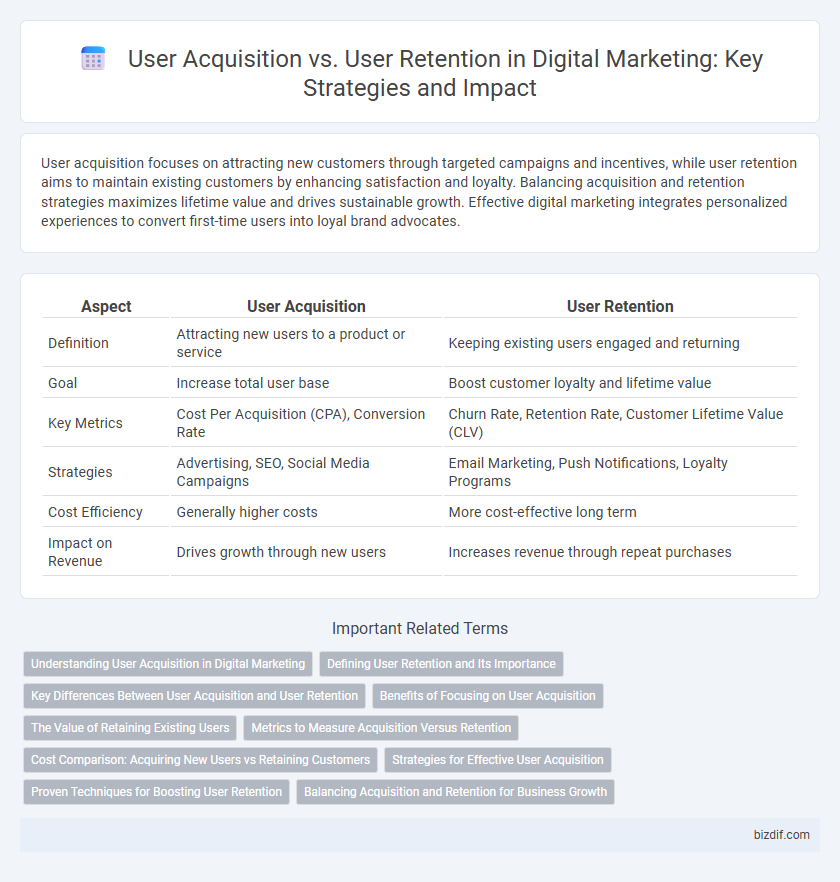User acquisition focuses on attracting new customers through targeted campaigns and incentives, while user retention aims to maintain existing customers by enhancing satisfaction and loyalty. Balancing acquisition and retention strategies maximizes lifetime value and drives sustainable growth. Effective digital marketing integrates personalized experiences to convert first-time users into loyal brand advocates.
Table of Comparison
| Aspect | User Acquisition | User Retention |
|---|---|---|
| Definition | Attracting new users to a product or service | Keeping existing users engaged and returning |
| Goal | Increase total user base | Boost customer loyalty and lifetime value |
| Key Metrics | Cost Per Acquisition (CPA), Conversion Rate | Churn Rate, Retention Rate, Customer Lifetime Value (CLV) |
| Strategies | Advertising, SEO, Social Media Campaigns | Email Marketing, Push Notifications, Loyalty Programs |
| Cost Efficiency | Generally higher costs | More cost-effective long term |
| Impact on Revenue | Drives growth through new users | Increases revenue through repeat purchases |
Understanding User Acquisition in Digital Marketing
User acquisition in digital marketing involves strategies designed to attract new customers through channels like social media advertising, search engine marketing, and influencer partnerships. Effective user acquisition depends on data-driven targeting and personalized content to maximize conversion rates and reduce customer acquisition costs (CAC). Prioritizing user acquisition lays the foundation for expanding market reach and increasing brand visibility in competitive digital landscapes.
Defining User Retention and Its Importance
User retention refers to the ability of a digital marketing strategy to keep customers engaged and returning to a product or service over time, measured by metrics such as retention rate and customer lifetime value (CLV). High user retention is crucial for sustainable business growth, as acquiring new users often costs five times more than retaining existing ones. Focusing on personalized content, seamless user experience, and effective communication can significantly enhance user retention and maximize long-term revenue.
Key Differences Between User Acquisition and User Retention
User acquisition focuses on attracting new customers through targeted campaigns, SEO, and paid advertising to expand the user base, while user retention emphasizes maintaining existing customers by enhancing user experience, personalized communication, and loyalty programs. Acquisition metrics include cost per acquisition (CPA) and click-through rates (CTR), whereas retention metrics prioritize customer lifetime value (CLV) and churn rate reduction. Effective digital marketing strategies balance both approaches to drive sustainable growth and maximize return on investment (ROI).
Benefits of Focusing on User Acquisition
Focusing on user acquisition drives rapid growth by expanding the customer base and increasing brand awareness through targeted campaigns and strategic advertising. It enables businesses to capture new market segments, boosting revenue potential and enhancing competitive advantage in digital marketing. High user acquisition rates provide valuable data insights, facilitating optimized marketing strategies and long-term scalability.
The Value of Retaining Existing Users
Retaining existing users in digital marketing significantly increases customer lifetime value by reducing acquisition costs and fostering brand loyalty. Engaged users are more likely to make repeat purchases and advocate for the brand, driving organic growth. Strategies like personalized content, exclusive offers, and responsive customer support optimize retention and enhance overall marketing ROI.
Metrics to Measure Acquisition Versus Retention
User acquisition metrics include cost per acquisition (CPA), click-through rate (CTR), and conversion rate, which track how effectively new users are brought to the platform. User retention metrics focus on customer lifetime value (CLV), churn rate, and retention rate, measuring how successfully the business keeps users engaged over time. Comparing these metrics helps optimize marketing strategies by balancing the expense of attracting new users against the profitability of maintaining existing customers.
Cost Comparison: Acquiring New Users vs Retaining Customers
Acquiring new users in digital marketing often requires higher investment, with customer acquisition costs (CAC) averaging five times more than retention expenses. Retaining customers leverages existing relationships, driving repeat purchases and reducing marketing overhead, ultimately enhancing customer lifetime value (CLV). Brands focusing on retention benefit from lower churn rates and increased profitability compared to the fluctuating costs of acquiring new users.
Strategies for Effective User Acquisition
Effective user acquisition strategies in digital marketing prioritize targeted advertising, leveraging data-driven insights to reach high-potential audiences across multiple channels such as social media, search engines, and influencer partnerships. Optimizing landing pages and utilizing personalized content increase conversion rates by aligning messaging with user intent and behavior. Implementing robust tracking and analytics tools enables continuous campaign refinement and improved return on investment.
Proven Techniques for Boosting User Retention
Effective user retention strategies include personalized email campaigns, loyalty programs, and in-app engagement features that increase user lifetime value (LTV). Data-driven approaches such as behavioral segmentation and predictive analytics help identify churn risks and tailor retention efforts. Mobile push notifications with timely, relevant content achieve higher re-engagement rates compared to generic messaging, directly boosting user retention metrics.
Balancing Acquisition and Retention for Business Growth
Balancing user acquisition and user retention is crucial for sustainable digital marketing success, as acquiring new users typically costs five times more than retaining existing ones. Effective strategies prioritize acquisition to expand market reach while simultaneously enhancing customer retention through personalized engagement and loyalty programs. Optimizing the balance between acquisition cost and lifetime customer value drives long-term business growth and maximizes return on investment.
User acquisition vs user retention Infographic

 bizdif.com
bizdif.com